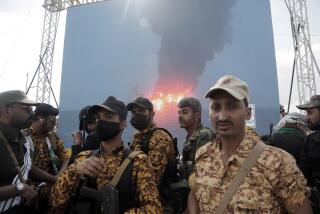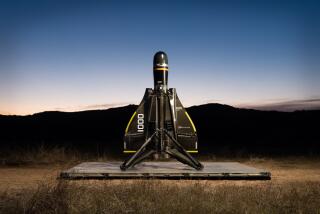Global Hawk Crashes in Afghanistan in a Setback for High-Tech Drones
- Share via
WASHINGTON — An unmanned U.S. spy aircraft has crashed in Afghanistan, U.S. military officials said Monday, in a reminder that one of the most important new technologies in the war against terrorism is fragile and only partially developed.
The RQ-4A Global Hawk that crashed during a routine flight Sunday was rushed into the theater in November to help U.S. forces track enemy fighters. Pentagon officials say the Global Hawk and the older, lower-flying RQ-1 Predator drone will be central to their effort to track down Islamic militants in South Asia and around the world.
But the crash, which occurred for reasons that were still unclear Monday, means U.S. forces have already lost one of two Global Hawks they had in the theater. Several Predators have also crashed in surveillance missions in Afghanistan and Iraq since the war began, analysts say.
The losses come at a time when Pentagon officials have already expressed concern that their worldwide anti-terror campaign will be crimped by the limited availability of the surveillance aircraft.
U.S. military officials at Central Command in Tampa, Fla., which is overseeing the war, said the Global Hawk crashed about midday Sunday as it was returning from a routine patrol in or around Afghanistan. They said the crash was not the result of enemy fire, but declined to provide other details.
Despite a long history of crashes and high costs, unmanned reconnaissance planes have become an increasingly attractive technology to the Pentagon.
At a time of growing emphasis on battlefield intelligence gathering and precision bombing, these remotely controlled craft offer commanders detailed, real-time images from flights that last dozens of hours or even days.
The Predator, which can stay aloft for nearly 24 hours, carries radar that functions through cloud cover along with infrared sensors that can generate images in low light. Predator video cameras have transmitted live feeds to AC-130 gunship crews, enabling them to find and destroy targets on the ground.
The Predators, which fly up to 140 mph at altitudes up to about 25,000 feet, have also been modified to carry Hellfire heat-seeking missiles.
The 44-foot-long Global Hawk flies far higher, for a wider view of the landscape. It can reach altitudes above 60,000 feet yet can produce still images that allow analysts to distinguish one tire track from another.
Its speed of 400 mph and its high altitude put it out of range of enemy fire.
With these capabilities in mind, President Bush last month cited the Predator and the Global Hawk as examples of the kind of “transformational” defense technologies whose development the Pentagon needs to accelerate.
Even so, the planes have weaknesses.
The Predator’s relatively slow speed and low altitude make it vulnerable to enemy fire. At its lower altitudes, it also accumulates ice on the wings, thus making it unsuitable for use in northern Afghanistan during the winter.
In October, Thomas P. Christie, director of the Pentagon’s office of operational test and evaluation, issued a report citing several shortcomings of the Predator. He said the drone had “poor target location accuracy,” broke down too often, had ineffective communications and was hampered in intelligence gathering even by “relatively benign weather.”
“It cannot operate in less than ideal weather,” Christie said.
About one-third of the 60 Predators that have been built have crashed, analysts say.
The Global Hawk also has limits. Although its altitude puts it out of range of enemy fire, the plane is too high for video cameras to be used.
Though Air Force officials praise the Global Hawk’s flight performance to date, they also acknowledge that the plane’s development is at a relatively early stage. It is manufactured by Northrop Grumman Corp. and assembled in Palmdale.
In an illustration of the plane’s vulnerability to human error, a Global Hawk prototype crashed at China Lake Naval Weapons Center in May 1999 when it was unintentionally sent an electronic signal to terminate the flight, illustrating the plane’s vulnerability to human error.
John Pike, a defense and intelligence specialist at the research group https://GlobalSecurity.org, said the Global Hawk, while not known to have any particular performance problems, also has a relatively short test flight history.
Defense Secretary Donald H. Rumsfeld offered favorable comments last month about the Global Hawk’s performance in the war. But he noted that its use in the theater had been limited.
Deputy Defense Secretary Paul D. Wolfowitz acknowledged last month that the Pentagon needs to buy more drones and figure out how best to use them.
“We’re learning we don’t have enough of them, and we’re still ironing out the bugs in terms of how to make best use of them,” Wolfowitz said.
At the same time, he said, the Defense Department will substantially boost funding for development of the drones, and he suggested that the Pentagon had been remiss in not moving more swiftly on the program.
“I would say the shortage of [drones] is a wake-up call,” Wolfowitz said.
*
Times staff writer Esther Schrader contributed to this report.
More to Read
Sign up for Essential California
The most important California stories and recommendations in your inbox every morning.
You may occasionally receive promotional content from the Los Angeles Times.











